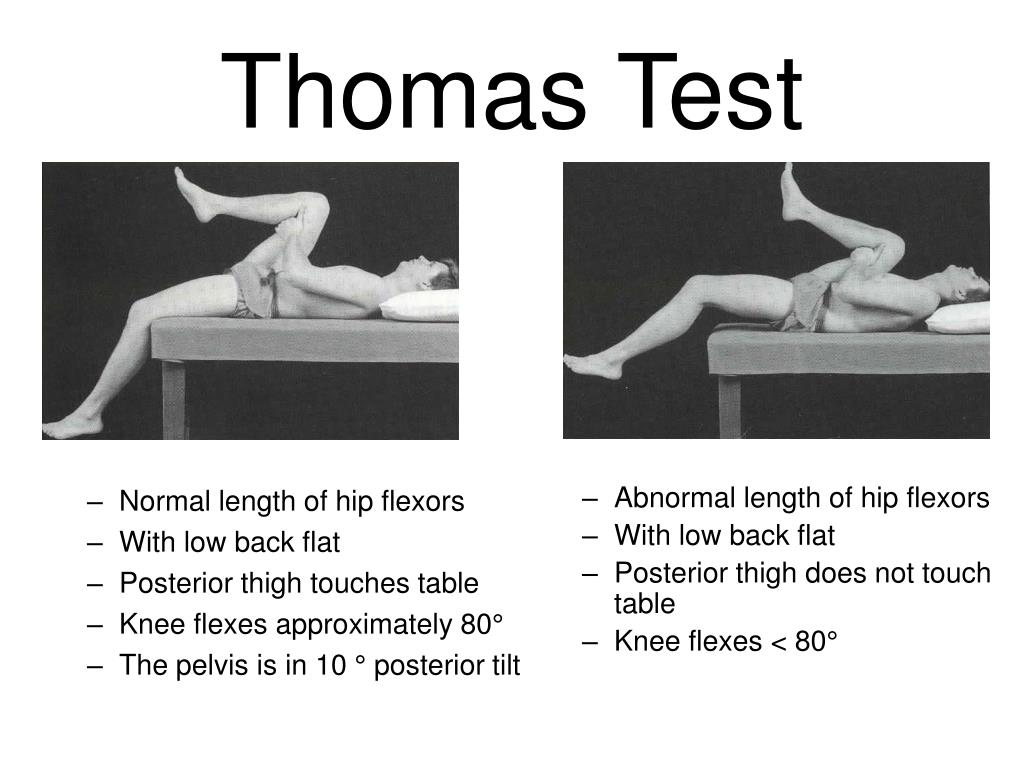
PPT The Thigh and Hip Muscles Anatomy, Injuries and Assessment PowerPoint Presentation ID
The Thomas Test is used to assess tightness in the hip flexors and knee extensors. If the hip flexors are tight, the thigh of the dangling extremity inclines toward the ceiling; if the knee extensors are tight, the dangling leg inclines away from the examining table. The patient in the photograph demonstrates tight knee extensors and hip.

The Thomas Test for Hip Flexibility How Fit Are You Really? YouTube
Thomas' test is a reliable means of assessing such deformity even when both hips are affected. The patient is laid on their back and both hips flexed simultaneously to their limit. This position obliterates any excessive lordosis, and this should be confirmed by placing a hand behind the spine. With one hip held firmly in position - so keeping.

The Thomas Test for Hip Flexion YouTube
The Thomas test, named after Dr Hugh Owen Thomas, is used to measure the flexibility and/or assess the tightness of the hip flexors. The patient is supine, the affected limb is maximally flexed to the chest. The unaffected limb should be left in extension and resting on the examination table.

Thomas test hip flexor strengthening
The Thomas Test is mentioned several times in the literature to measure both shortening of the iliopsoas and to test for femoroacetabular impingement syndrome (FAI). McCarthy et al. (1995) obtained very good positive and negative likelihood ratios of 11.1 and 0.12, respectively, regarding the Thomas test's ability to diagnose variable hip.

Modified Thomas Test for Knee and Hip Clinical Physio YouTube
Special Test for hip flexor tightness. Find more assessment content in the orthopedics section at www.pthaven.com.

The modified Thomas test is not a valid measure of hip extension unless pelvic tilt is
Thomas's test. Thomas's test is used to assess for a fixed flexion deformity (i.e. an inability for the patient to fully extend their leg). 1.. Trendelenburg's test is used to screen for hip abductor weakness (gluteus medius and minimus). 1. With the patient upright, stand in front of them and ask them to place their hands on your.

Testing Hip Mobility with The Thomas Test YouTube
The Thomas Test (also known as Iliacus Test or Iliopsoas Test) is used to measure the flexibility of the hip flexors, which includes the iliopsoas muscle gro.

test de thomas
The Thomas test is a physical examination test, first described in 1875 by the Welsh bonesetter Hugh Owen Thomas (1834-1891). The test was used to diagnose hip flexion contracture and determine the duration of the disease process. The modified Thomas test is most often used to asses and evaluate flexibility of the hip flexors including the.

How to Screen Hip Mobility Squat University
The Thomas test is used to determine whether there is tightness in the hip flexors. With the patient in the supine position, ask the patient to fully flex one hip. Observe the contralateral side.

Thomas' Sign for Hip Flexor Tightness YouTube
Thomas test. evaluates hip flexion contractures. Extension. 20-30 deg. Abduction. 40-50 deg. Adduction. 20-30 deg. Internal rotation. 30 deg. External rotation. 50 deg. Special Tests. FADIR test. hip F lexed to 90 deg, AD ducted and Internally R otated.. Stinchfield resisted hip flexion test.

Hip Exam Thomas Test for Hip Flexor Strain or Tightness YouTube
Test for contracture of hip flexors or anterior ligamentous structures.the test is positive if the opposite hip flexes during the test or the opposite knee a.

Thomas Test Hip Flexor Assessment YouTube
Enroll in our online course: http://bit.ly/PTMSK DOWNLOAD OUR APP:📱 iPhone/iPad: https://goo.gl/eUuF7w🤖 Android: https://goo.gl/3NKzJX GET OUR ASSESSMENT B.

How to do the Modified Thomas Test for the hip flexors YouTube
The original Thomas test was designed to test the flexibility of the iliopsoas complex but has since been modified and expanded to assess a number of other soft tissue structures. It's a test for hip flexor tightness. It was first described by as developed by Dr. Hugh Owen Thomas, a British orthopedic surgeon (1834-1891).

THOMAS TEST Orthopedic Exam for Hip, Knee and Low Back Pain YouTube
The Thomas test is a physical examination test, named after the Welsh orthopaedic surgeon, Hugh Owen Thomas (1834-1891), to rule out hip flexion contracture (fixed partial flexion of the hip) and psoas syndrome (injury to the psoas muscle).. Illustration of the Thomas test. From Hugh Thomas Owen's "Diseases of the hip, knee, and ankle joints: with their deformities, treated by a new and.

Hip Mobility Assessment Modified Thomas Test YouTube
Performance. Thomas' test is negative when the subject's lumbar spine (lower back) and sacrum are able to remain flat on the table during the maneuver. The hip should be able to reach 10 degrees of extension, and the knee should be able to flex 90 degrees. Conversely, a Thomas test is said to be positive when:

Thomas Test Iliopsoas Tightness YouTube
The Thomas test is used to rule out hip flexion contracture and psoas syndrome. Often associated with runners, dancers, and gymnasts who complain of hip stiffness when flexing at the waist. The hip flexor is a group of muscles that allow us to lift our knees and bend at the waist. Hip flexors perform various functions, and where some cross over.